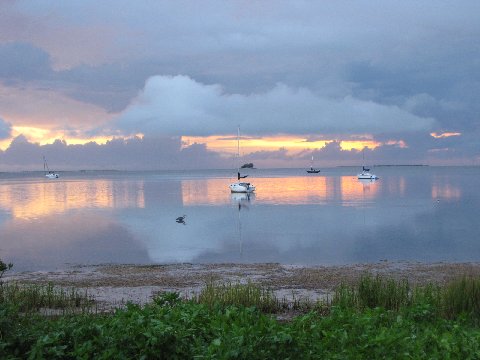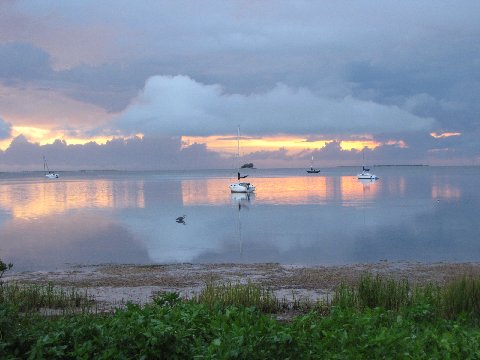 What horrors lurk beneath? Photo courtesy kthypryn via FlickrThe White House tied a nice little ribbon around the Gulf spill yesterday, but things were a bit messier on Capitol Hill. Up there, the subject was dispersants and what spraying the Gulf with 1.8 million gallons of them was doing to deep sea life.
What horrors lurk beneath? Photo courtesy kthypryn via FlickrThe White House tied a nice little ribbon around the Gulf spill yesterday, but things were a bit messier on Capitol Hill. Up there, the subject was dispersants and what spraying the Gulf with 1.8 million gallons of them was doing to deep sea life.
Toxic crock: As with everything in Congress these days, attitudes about dispersant-dumping at the Senate hearing broke down along party lines. (See Matthew Wald’s New York Times Green blog.) Republicans tended to view dispersants as the lesser of two evils, the one that apparently kept oil from soaking Gulf and East Coast beaches. Democrats were less sanguine, clearly not happy with how little EPA officials know about the long-term impact of Corexit, BP’s dispersant of choice. Sen. Sheldon Whitehouse (D-R.I.), for one, was not convinced by the EPA’s recent test, which concluded that Corexit is slightly less toxic than the oil. Wald wrote:
Mr. Whitehouse also pointed out that the test for toxicity is useless for evaluating another threat, the release of chemicals that could disrupt the endocrine systems of sea animals and, possibly, humans. The reason is that the toxicity is measured by putting shrimp and fish into higher and higher concentrations until they die; that does not allow for testing longer-term effects.
The sweet life: Robert Carney, an oceanographer at Louisiana State University, broke it down for The Wall Street Journal‘s Jeffrey Ball, comparing the EPA’s methodology to testing people for the effects of sugar after they’ve gorged on it:
It would conclude that it isn’t great for our health but it isn’t going to kill us, yet a lifetime of sugar can kill you. We worry about similar things in the environment.
Like he said: One person who wasn’t in the Senate hearing room, unfortunately, was EPA whistleblower Hugh Kaufman. But he did share with the Institute for Public Accuracy 10 questions he would have asked Paul Anastas, the assistant administrator who represented the EPA. Among Kaufman’s queries:
… you stated that biodegradation of the oil spilled in the Gulf was 50 percent faster when dispersants were used. This assertion is in direct conflict with evidence of a report describing the Amoco Cadiz oil spill in France in 1978, in which dispersed oil is still not biodegraded. What scientific basis do you have for your conflicting assertion?
Black to the future: The growing consensus is that for all the 4.1 million barrels of oil that poured into the Gulf, this has been something of a stealth spill, one whose true treachery won’t be known for years.
Writes Bob Cesca in the Huffington Post:
But the press, government officials, and BP pitchmen are insulting our intelligence by suggesting that the oil has vanished and there’s nothing to worry about. From a political perspective it’s easy to see why everyone wants to make it appear as though the response was successful and they were able to achieve the impossible. Whatever short-term gains this might provide in terms of approval ratings or the confidence of the American people, however, will surely be undermined when the true long-term environment impact emerges.
The BBC’s Richard Black was more elegiac:
… even a preliminary reckoning will have to wait until the first wintering birds have returned, shrimping boats have cast their nets again right across their grounds, and the wetland grasses have had a first chance to shed their oily carapaces and sprout anew in a fresh spring.
Feel the ooze between your toes: As to the simple question of the week — “Where’s the oil?” — John Snell, reporting for WVUE in New Orleans, has a simple answer: It’s gone underground:
… local officials dispatched a dive team to a barrier island off of southeastern Louisiana’s Plaquemines Parish to scan the sea floor for oil. The team, however, could barely see the sea floor, due to the current murky state of the area waters. But when the divers returned to shore, they made a rather remarkable discovery: Tiny holes that burrowing Hermit crabs had dug into the ground effectively became oil-drilling holes. When the divers placed pressure on the ground near the holes, oil came oozing up.
Creature discomforts: And the people who know the Gulf waters best, its fishers, aren’t convinced their worst days are behind them. While they’re happy to be fishing again, they say they’re seeing strange things out there on the water. A report by WLOX in Biloxi, Miss., quotes fisherman Mark Stewart:
All the sea life is trying to get out of the water. The turtles are all out there with their heads sticking out of the water trying to get air. It’s not normal.
And fisherman Danny Ross:
Sea creatures that are normally bottom species are on top of the water due to the water column is so full of dispersants. The oxygen level is so low. A horseshoe crab, it’s on top of the water trying to swim. We’ve never seen that in our life. We might not be biologists, but we know our waters. This is not normal.
Birds gotta swim, fish gotta fly.



